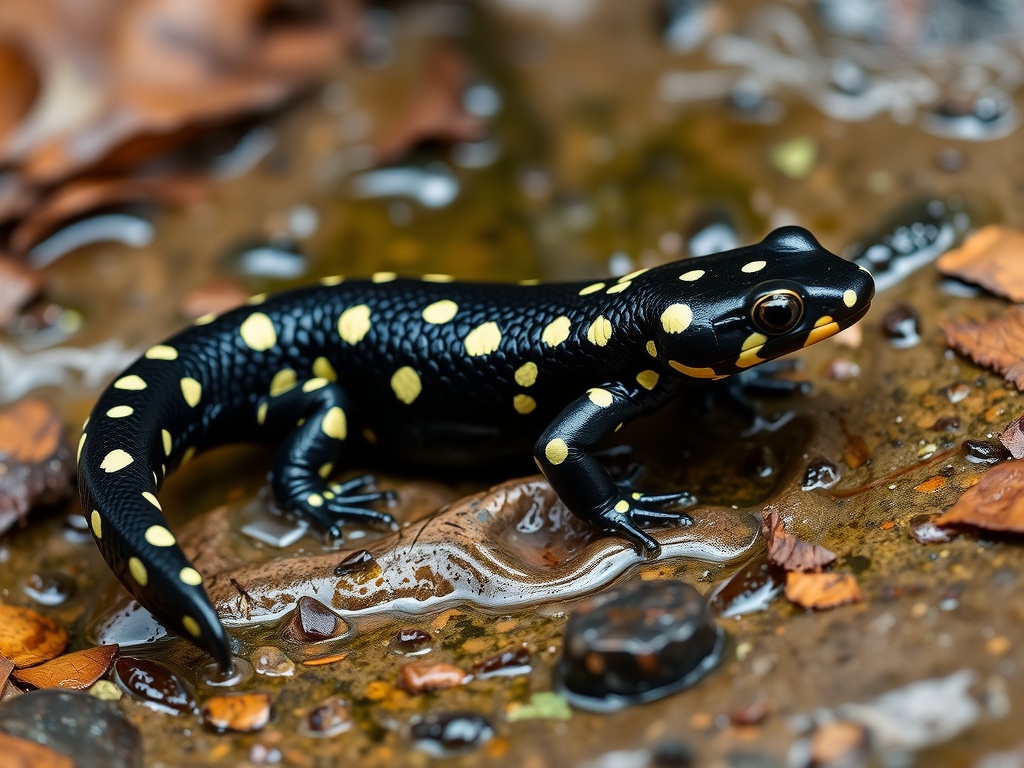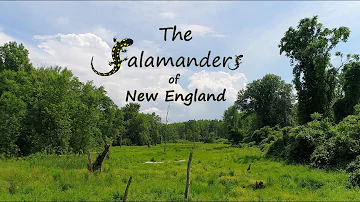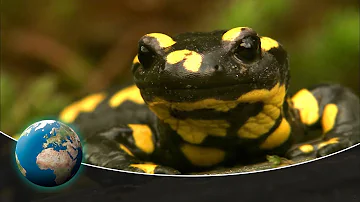
Spotted Salamander
Ambystoma maculatum

Meet the Spotted Salamander
The Spotted Salamander is a striking amphibian known for its glossy black or dark blue body adorned with bright yellow or orange spots. This medium-sized mole salamander spends most of its life underground, emerging primarily during rainy nights in spring to breed in vernal pools. Its secretive lifestyle makes it rarely seen despite being widespread in eastern North America. Spotted Salamanders play an important ecological role in forested ecosystems, serving as both predators and prey.
Classification
Amphibian
Habitat
Deciduous forests near vernal pools and temporary freshwater ponds
Diet
Carnivore
Lifespan
10-20 years
Conservation
Least Concern
Weight
15-30 grams
📖Fascinating Facts
Bright Spots
The vivid yellow or orange spots on the Spotted Salamander's back serve as a warning to predators about their mild toxicity.
Algae Allies
Their eggs often contain green algae that not only provide oxygen but also speed up the development of the embryos.
Rainy Night Travelers
Spotted Salamanders migrate en masse to breeding pools during rainy spring nights, often covering considerable distances.
📋Detailed Description
The Spotted Salamander (Ambystoma maculatum) is a robust, medium-sized mole salamander, typically measuring 15–25 cm (6–10 in) in total length, with females generally larger than males. Its skin is smooth and moist, colored deep bluish-black to slate gray, and adorned with two irregular rows of bright yellow or orange spots running from the head to the tail. The ventral surface is pale gray, sometimes with faint mottling. Adapted for a fossorial lifestyle, it has a broad head, small eyes with vertical pupils, and stout limbs equipped with four toes on the forelimbs and five on the hindlimbs. Spotted Salamanders are secretive and spend most of their lives underground in burrows, emerging mainly during early spring rains to breed. They possess a remarkable regenerative ability, capable of regrowing lost limbs and even parts of their spinal cord. Their skin contains granular glands that secrete a mild toxin as a defense against predators. Notably, their eggs host a unique symbiotic relationship with the green alga Oophila amblystomatis, which enhances embryonic development by providing oxygen and possibly nutrients. This species is long-lived for an amphibian, with individuals in the wild known to survive for over 20 years.
💡 Did you know?
Spotted Salamanders can live for up to 20 years in the wild, making them one of the longest-lived salamander species.
🔬Research & Sources
Wikipedia Summary
The spotted salamander, also known commonly as the yellow-spotted salamander, is a species of mole salamander in the family Ambystomatidae. The species is native to the eastern United States and Canada. It is the state amphibian of Ohio and South Carolina. The species ranges from Nova Scotia, to Lake Superior, to southern Georgia and Texas. Its embryos have been found to have symbiotic algae living in and around them, the only known example of vertebrate cells hosting an endosymbiont microbe.
Last Modified: 5/26/2025
🎭Behavior & Social Structure
Spotted Salamanders are primarily nocturnal and exhibit strong site fidelity, often returning to the same breeding pools year after year. They are solitary outside of the breeding season, spending most of their time in moist leaf litter or in burrows created by small mammals. Their diet consists mainly of earthworms, slugs, snails, spiders, and a variety of insects and their larvae, which they hunt using a sit-and-wait strategy, relying on chemosensory cues and rapid tongue projection. During the brief breeding season, large numbers may congregate at vernal pools, where males perform elaborate courtship dances and deposit spermatophores for females to collect. Outside of breeding, they are rarely seen above ground except during rainy nights. They exhibit homing behavior, using olfactory and geomagnetic cues to navigate back to their natal pools.
👶Reproduction & Life Cycle
Breeding occurs once annually, typically from late winter to early spring (February–April), triggered by warm rains and rising temperatures. Males arrive at breeding pools first and engage in courtship displays, nudging and circling females before depositing spermatophores on submerged substrates. Females pick up the spermatophores with their cloaca, leading to internal fertilization. Each female lays 100–250 eggs in gelatinous masses attached to submerged vegetation or debris. The eggs hatch after 30–60 days, depending on water temperature. Larvae are fully aquatic, possessing external gills and a finned tail, and undergo metamorphosis into terrestrial juveniles after 2–4 months. There is no parental care after egg deposition. Sexual maturity is reached at 2–4 years of age.
🛡️Adaptations & Survival
Spotted Salamanders exhibit several adaptations for a subterranean lifestyle, including a streamlined body, reduced eyesight, and a reliance on chemosensory cues. Their skin secretes toxins (mainly tetrodotoxin-like compounds) that deter predators such as snakes and mammals. The symbiotic relationship with Oophila amblystomatis algae in their eggs is unique among vertebrates, enhancing oxygen availability and possibly providing photosynthetically derived nutrients to developing embryos. Their ability to regenerate complex tissues, including limbs and parts of the heart and brain, is of significant scientific interest. Seasonal migration to vernal pools reduces predation risk for larvae, as these pools are fishless and temporary.
📚Research Sources
🎨Cultural Significance
The Spotted Salamander is the state amphibian of Ohio and South Carolina, symbolizing the importance of amphibian conservation in these regions. It is featured in environmental education programs and is often used as a flagship species for the protection of vernal pool habitats. In folklore, salamanders have historically been associated with fire and transformation, though the Spotted Salamander itself is not commonly featured in mythology. Its striking appearance and unique life cycle have made it a subject of fascination for naturalists and educators.
🔬Recent Research & Discoveries
Recent research has focused on the molecular mechanisms underlying limb regeneration in Spotted Salamanders, providing insights with potential applications in regenerative medicine. The symbiotic relationship between salamander embryos and Oophila algae remains a topic of active investigation, particularly regarding the exchange of metabolites and the evolutionary origins of this association. Studies using genetic markers have revealed high levels of site fidelity and limited gene flow between populations, emphasizing the importance of habitat connectivity. Ongoing monitoring programs track population trends and the impacts of environmental change on breeding success.
🎥Wildlife Videos

Search For The Spotted Salamander
Hey everyone, the time has finally come! Search For The Spotted Salamander is a documentary dedicated to the amazing animal ...
The Salamander Wilds

Spotted Salamanders: Everything You Need To Know! ~ 4k
Spotted salamanders are some of the largest terrestrial salamanders in North America, but habitat destruction is threatening their ...
The Wild Report

Spotted salamanders' epic journey through the Algonquin forest to breed
Every spring, as temperatures warm up, spotted salamanders emerge from their winter dormancy and begin a migration of epic ...
The Nature of Things

The Salamanders of New England
Salamanders are plentiful in many forests, but due to their underground (or underwater) lifestyles, for the most part are not often ...
New England Forests

Nocturnal wanderer: The fire salamander
Almost everyone knows of him, but very rarely does anyone actually get to see this nocturnal wanderer. This is because he leads ...
Free High-Quality Documentaries

Fire Salamander - The Last Urban Dragon | Free Documentary Nature
Fire Salamander - The Last Urban Dragon | Free Documentary Nature Watch 'Fire Salamander - Spectacular Footage of the ...
Free Documentary - Nature
🌍Habitat Information
The Spotted Salamander typically inhabits Deciduous forests near vernal pools and temporary freshwater ponds environments. Spotted Salamanders have adapted to their environments with specialized features and behaviors.
Primary Habitat:
Deciduous forests near vernal pools and temporary freshwater ponds
More detailed habitat information will be available soon.
🛡️Conservation Status
The Spotted Salamander is currently classified as Least Concern. Conservation efforts are crucial for preserving this species for future generations.
Common Threats:
- 🏠Habitat loss and fragmentation
- 🌡️Climate change impacts
- 🎯Hunting and poaching
- 🏭Human-wildlife conflict
⚠️Threats & Conservation Challenges
While currently listed as Least Concern by the IUCN, Spotted Salamanders face threats from habitat fragmentation, road mortality during breeding migrations, pollution (particularly from road salt and pesticides), and loss of vernal pool breeding sites due to land development. Climate change poses additional risks by altering precipitation patterns and hydroperiods of breeding pools. Populations are stable in many areas, but local declines have been documented where suitable habitat is lost or connectivity between terrestrial and aquatic habitats is disrupted.
🔬Scientific Classification
Scientific Name
Ambystoma maculatum
Classification Hierarchy
🔍 About Taxonomic Classification
Taxonomic classification is a hierarchical system used by scientists to classify and organize living organisms based on shared characteristics and evolutionary relationships.
The system moves from broad categories (Kingdom) to increasingly specific ones, with each animal's scientific name typically consisting of its Genus and species.
📝Community Notes
Share your observations and insights about the Spotted Salamander with our community of wildlife enthusiasts.
Join Our Community
Sign in to share your observations and connect with fellow wildlife enthusiasts.
Sign In to ContributeNo community notes yet
Be the first to share your observations about the Spotted Salamander!
Explore Spotted Salamander
Select a tab above to learn more about this amazing animal.
📸Photo Gallery
No photos available for this animal yet.
🌟Discover More Wildlife
Continue your journey of discovery with more fascinating animals from our database
